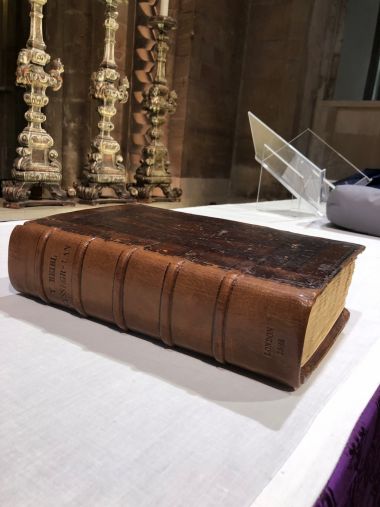Rosh Hashana, monarchy and memories

Jewish academic and Hebrew scholar Irene Lancaster reflects on Rosh Hashana, the Jewish New Year.
Just one week after the state funeral of the Queen comes Rosh Hashana, the Jewish New Year. This year Rosh Hashanah falls on Sunday night 25 September.
There are many aspects of this festival which appear to have been reflected in at least two of the religious services held in recent days.
I first want to start with the reading given at the service of reflection for the Queen on 13 September in Northern Ireland. This reading was taken from the Hebrew Bible, Joshua chapter 4. This passage reenacts the crossing of the Reed Sea under the guidance of Moses, when the Children of Israel were first led out of Egypt on their journey via the Wilderness into the Promised Land of Israel.
This time, however, Joshua, having taken on the mantle of Moses, also crosses over - the River Jordan - into the Promised Land of Israel itself. As with the original Reed Sea, the waters of the Jordan part and then come
together again after the people have passed over, carrying with them the precious Ark of the Covenant.
Twelve men had been chosen, one for each of the twelve Jewish tribes, and each took one stone and laid it down. These twelve stones were to be a 'sign' for their children, as well as a 'memorial' forever, still there 'to this day'.
The point of the entire exercise is to carry on the tradition from one generation to the next, the word for stone being 'even', an anagram of 'father'(av) and 'son' (ben) in Hebrew.
So this rather difficult passage heralds the transmission of the weight of the religion, tradition and teaching onto the next generation, by means of a type of oral communication, signified by the 'stones', from parent to child. Through the 'stones' the younger generation will be empowered to carry on the task handed down to them by the parents.
On Friday 16 September, another service for the Queen took place in Wales, in the ancient Llandaff Cathedral. On this occasion, the Bible used was specially loaned from the National Library of Wales.
This, the William Morgan Bible, was the very first Bible to be translated, in 1588, from Hebrew and Greek into Welsh. It is named after its translator, Bishop of Llandaff and St Asaph, whose endeavours helped to popularize both the Welsh language and the teachings of the Bible itself.
The First Minister read in Welsh from I Kings chapter 3, which was mentioned by former Archbishop of Canterbury, Rowan Williams, during our most recent joint dialogue on leadership for Christian Today.

The Welsh language appears to have had something of a renaissance in Wales itself, which is a very good thing indeed. And youth played a very large part in all the events for the day. At the Cathedral, two very young children, wearing gloves, carried the sacred ancient Bible to its place, and later the King and Queen were introduced to members of the Welsh Youth Parliament.
In Kings, G-d appears to Solomon in a dream and asks him what He should give him. And Solomon responds that he is but 'a little child' compared to his father David, and will need help if he is to rule wisely in the place of his revered predecessor. Therefore Solomon asks for 'a listening heart' in order to be able to 'judge' and 'discern', 'for who is able to judge this weighty people?'
And after that reading by the Welsh First Minister, we heard one of our favourite Jewish prayers, Psalm 121, sung in Welsh: 'I lift up my eyes to the hills: from where does my help come?' Truly a momentous and inspiring occasion which spoke very much to the heart of another small people, the Jewish people, for whom the Hebrew language also means everything.
The whole day, in every venue, was accompanied on the harp - a true touch of genius, reminiscent of the time of the monarchs and priests of Israel, as well as of today, the Sea of Galilee being known as Kinneret - or 'harp' - in Hebrew.
Bearing in mind that this entire time period has been marked by monarchy, memories and the loud blowing of instruments, it is indeed striking that a key element of Rosh Hashana is the addition to the synagogue prayer service
of three special prayers introduced especially for this day. These additions are known as the Malchiyot, Zichronot and Shofarot.
The 3 Rosh HaShanah Prayers: Malchiyot, Zichronot and Shofarot celebrate G-d as the ruler of the universe. There may be many human monarchs, but there is only one true ruler, and that is G-d Himself. Zichronot are to do with memory, and act as a reminder. Our whole life passes before us. On this day we ponder the future and what the future will mean for us. But, it is all really in G-d's hands.
And, finally, we have the Shofarot, the sounds produced by the ram's horn repeatedly blown during the synagogue service and again 10 days later on Yom Kippur (the Day of Atonement). The Shofar provides another wake-up call.
Don't remain completely in the past; don't worry too much about the future, but concentrate on the present.
This upcoming period is to do with atonement and return to G-d. The word for 'atonement' (teshuvah) is actually the Hebrew word for 'return'. We may have travelled far, but we are now on the way back. And wherever we are in the
world, whether in foreign places or in our own homes, G-d can be reached anywhere and everywhere, as long as we reach out to Him, remember to pass on as much as we can, and not dwell unduly on the past.











